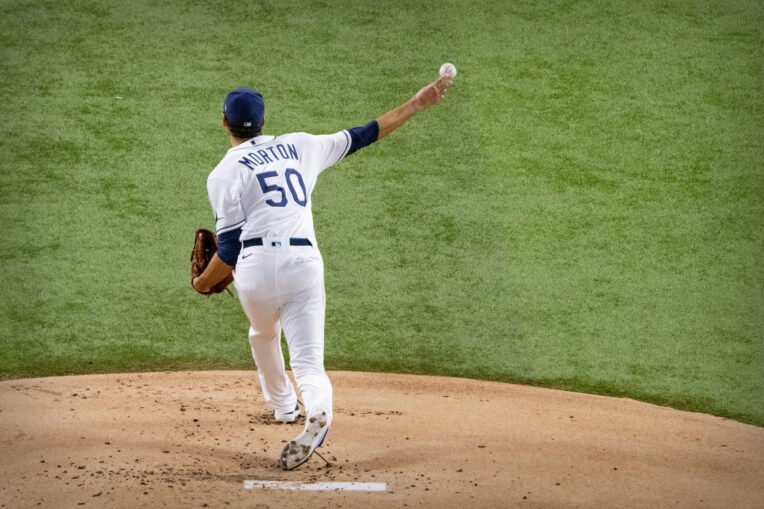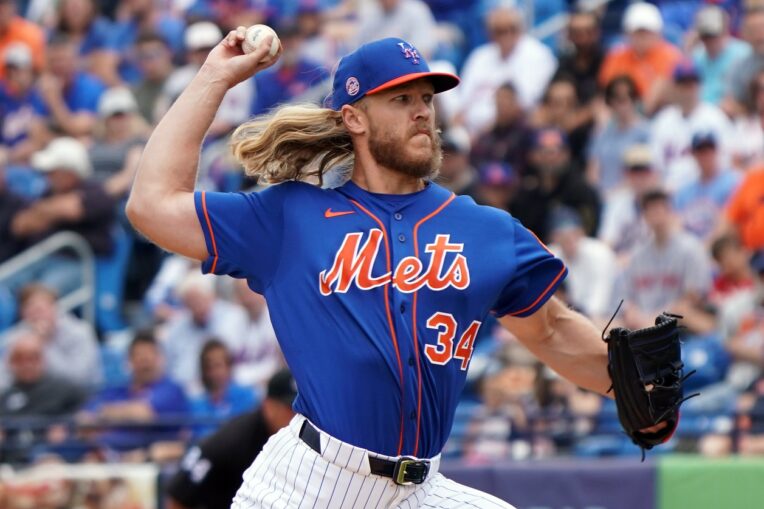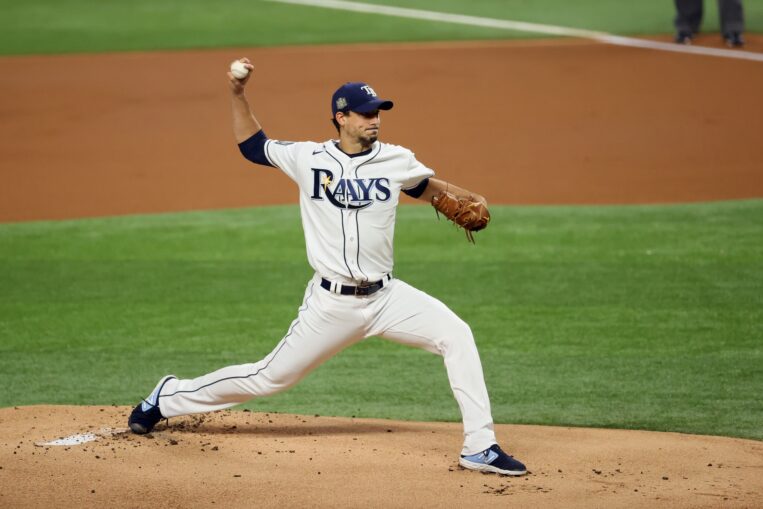Charlie Morton, Starting Pitcher
Bats/Throws: Right/Right
Age: 36 (Nov. 12, 1983)
Traditional Stats: 9 G, 9 GS, 38.0 IP, 4.74 ERA, 1.40 WHIP, 4 HR, 9.9 K/9, 2.4 BB/9
Advanced Stats: 41.6% GB, 10.5% HR/FB, 3.45 FIP, 4.01 xFIP, 3.97 SIERA, 90 ERA+, 0.9 fWAR/0.2 bWAR
Statcast Percentiles: 29th exit velo, 60th hard-hit, 38th barrel, 51st xBA, 60th xwOBA, 58th xSLG, 60th xERA, 56th K%, 37th whiff%, 37th fastball velocity, 51st fastball spin, 89th curveball spin
Rundown
Charlie Morton has recently cultivated a reputation as a clutch postseason starter, something that certainly matters a great deal when you’re designing a roster you hope to take into the playoffs. Throughout the last four years and between his last two teams, however, the veteran righty has also proven to be much more than a handful of shining moments.
Across his first nine years in the majors before signing with the Astros, Morton only managed an ERA+ of at least 100 on two occasions. Furthermore, one of these two achievements rested on a mere four-start season with the Philadelphia Phillies in 2016, one that ended in mid-May after Morton underwent surgery to repair a bad hamstring.
The two-year, $14 million deal he and the Astros agreed to that offseason seemed to take a number of folks in baseball by surprise, but by the time Houston had wrapped up its first World Series championship, Morton only stood beneath Justin Verlander (a future Hall of Famer) and Dallas Keuchel (a 2015 Cy Young award winner) as the club’s best arm. He was nominated to his first All-Star Game the following season, setting career-highs in wins (15), starts (30), and strikeouts (201). His then-career-high 2.0 bWAR from 2017 had now shot up to 3.8.
Even when Morton signed with the Tampa Bay Rays for two years and $30 million ahead of 2019, however, fans and analysts again cast their doubts. Never mind the fact that he had just turned 35, Morton now emerged from a Houston pitching staff that had seen conspicuous upgrades in fastball spin across the board, and other pitchers (read: Trevor Bauer) were starting to question the legitimacy of the rotation’s success at large.
Whatever sort of reversion to mediocrity people still held out for, though, didn’t come to pass. If anything, Charlie Morton in a Rays uniform has been one of the most dependable starting pitchers in all of baseball. And with the notoriously stingy Tampa Bay front office declining his club option for 2021, he could very well be a target of the Mets’ front office.
The obvious selling point when it comes to Morton’s ability is his scintillating 2019 campaign, where his bWAR again rose, this time to a club-leading 4.9.
Looking at the raw numbers, Morton treated us to 33 starts, 194.2 innings (both making for new career-highs), a 3.05 ERA (3rd in the American League), 1.08 WHIP (5th), 4.21 K/BB (5th), and a 2.81 FIP (2nd) and 3.28 xFIP (4th). He finished third in AL Cy Young voting behind two of his former teammates in Verlander and Gerrit Cole.
Morton’s success was clearly independent of some vague, larger-scale Astro initiative to doctor the baseball for better results, and truth be told, the righty completely enhanced his arsenal altogether last year. Per FanGraphs, 2019 marked a 15.7-run-above-average increase out of his curveball (9.6 to 25.3 – easily the highest in baseball) and a full 180-degree improvement in value out of his cutter (-3.9 to 3.9).
Of course, with everything great out on the table, the hangup we have to address is Morton’s stat line in 2020, because it was obviously a far cry from his past accomplishments.

The 37-year old’s average fastball velocity fell from 95 to 93.8 mph, his groundball rate fell nearly seven percent, and he never made it out of the sixth inning in any of his nine starts during the pandemic-shortened season. He also spent roughly three weeks between August and September on the injured list with shoulder inflammation.
Perhaps the injury is the best place to start, because several pitchers ultimately had a hard time adjusting to the mid-summer spring training ramp-up after three months in quarantine. Throwing through an underlying injury – as Morton evidently did through his first four starts – can explain not only the velocity dip, but also the subpar contact numbers. By the time Tampa Bay had decided to place him on the IL, he and his (on average) 92.5 mph fastball had spit out a 4.78 xFIP, with opponents hitting .296 with a 37.0% hard-hit rate and 11.1% barrel percentage.
The figures are certainly pedestrian, but upon his return, Morton shoved to a 93.9 mph average with his fastball. Over his last five games, he put up a much more palatable 3.42 xFIP, and the opponent average (.259), hard-hit rate (20.0%), and barrel percentage (5.0%) all followed suit. After allowing three homers in his first three starts of the year, Morton came back to allow just one in his final five (21.1 innings).
Now tucked behind Blake Snell and Tyler Glasnow in a formidable rotation commandeering the best team in the American League, Morton and his second-half recovery made for less of a storyline than it probably should have. In any case, his curveball remained upper echelon in horizontal movement (6.8 inches above average), despite a slightly diminished use pattern (37.3% to 32.7% usage).
It should be noted that seven of Morton’s nine total starts came against the same cast of eastern division rivals, with the worst of the four offenses (the Baltimore Orioles) ranking 14th out of the 30 big-league teams in wRC+ and OPS. And for what it’s worth, the veteran also lost 1.6 mph in fastball velocity between 2018 and his elite showing in 2019. Under some grisly circumstances early on, Morton bent, but he and his repertoire clearly did not break.
Contract
At the one-year, $8 million tag that MLBTradeRumors has projected for him, Morton would fit comfortably within the Mets’ offseason budget, and at great value, to boot. MLBTR even predicts Morton (and J.T. Realmuto) to come to that agreement with the Mets.
Given the Mets’ needs in the rotation, the match is, in many respects, too good to be true. In taking a step back to consider not only the market Morton would enter at this juncture in his career, but also his most recent statements about his future, it seems like more of a stretch.
When Morton signed his last deal with the Rays at the end of 2018, he told reporters he “fully expected” to retire at the conclusion of the deal. Of course, the deal carried an option for 2021, so that last year of baseball is still up in the air.
The righty is a Flemington, New Jersey native, and a graduate of the Joel Barlow High School in Redding, Connecticut, but he and his family have lived in Tampa Bay for a number of years, and he has been transparent in his desire to stay near them year-round:
“It’s going to be a decision,” Morton told reporters prior to game two of the ALCS this year. “Ideally, you want what’s best for your family. You want what’s best for the organization you play for. If that ends this year, I’m prepared to hang them up.
“The unknowns with COVID and this offseason, I don’t know what negotiations are going to look like with the league,” he added. “I don’t know what the situation is going to be like with our country or worldwide with the virus, what kind of protocols will be in place next year or even what job opportunities I’ll have next year.”
The Rays, despite declining his $15 million option, have hinted at potentially getting “creative” in their efforts to re-sign him. Unless New York can blow him and his family away from the financial side (it would likely take something closer to the $12-16 million range), Morton appears far more likely to stay in Tampa Bay than anything else.

Recommendation
Reality check notwithstanding, the Mets rotation would be moderately better with Charlie Morton in the two or three-spot than without.
What’s more, pulling him in for one final year would also keep the club’s payroll flexible going into the following offseason, when Clayton Kershaw, Lance McCullers, Dylan Bundy, and potentially Noah Syndergaard become free agents (among others). Winning a multi-year bid for Kevin Gausman, Jake Odorizzi, or Masahiro Tanaka, meanwhile, may hurt that window, however sustainable their numbers may also be.
A brief hiccup at the beginning of a rushed, abbreviated 2020 season cast a pall over what was an otherwise respectable campaign for Morton. His fastball velocity made it back to the 93-95 mph range, his curveball continued to snap at an elite rate, and he found a way to limit hard contact against lineups that were more than accustomed to him.
The righty’s ZiPS projections suggest he has another year or two of performances at this caliber, but it bears repeating that an $8 million trial for a local kid won’t move the needle. The Mets will have to negotiate AAV like a prince on the lighter side of 30, but it absolutely wouldn’t hurt to give him a call and make those accommodations. Charlie Morton should be an offseason target for the Mets’ front office.
















